Strategic Management Plan: Analyzing Asda's Business Strategy
VerifiedAdded on 2023/01/12
|14
|3353
|31
Report
AI Summary
This report presents a strategic management plan for Asda, a major UK retailer. It begins with an introduction to business strategy and its importance, followed by a detailed market analysis using PESTLE, SWOT, and Porter's Five Forces frameworks to assess the external and internal environments. The PESTLE analysis examines political, economic, social, technological, legal, and environmental factors influencing Asda. The SWOT analysis identifies the company's strengths, weaknesses, opportunities, and threats. Porter's Five Forces analysis evaluates the competitive landscape. The report then evaluates strategic directions using Porter's generic strategies, recommending a differentiation strategy. Finally, a strategic plan is proposed, focusing on online market expansion through e-commerce, setting objectives, and utilizing Ansoff's growth matrix to guide market penetration, development, and diversification. The plan aims to increase online sales and market share within a year, concluding with a summary of key findings and recommendations.

STRATEGIC
MANAGEMENT PLAN
MANAGEMENT PLAN
Paraphrase This Document
Need a fresh take? Get an instant paraphrase of this document with our AI Paraphraser
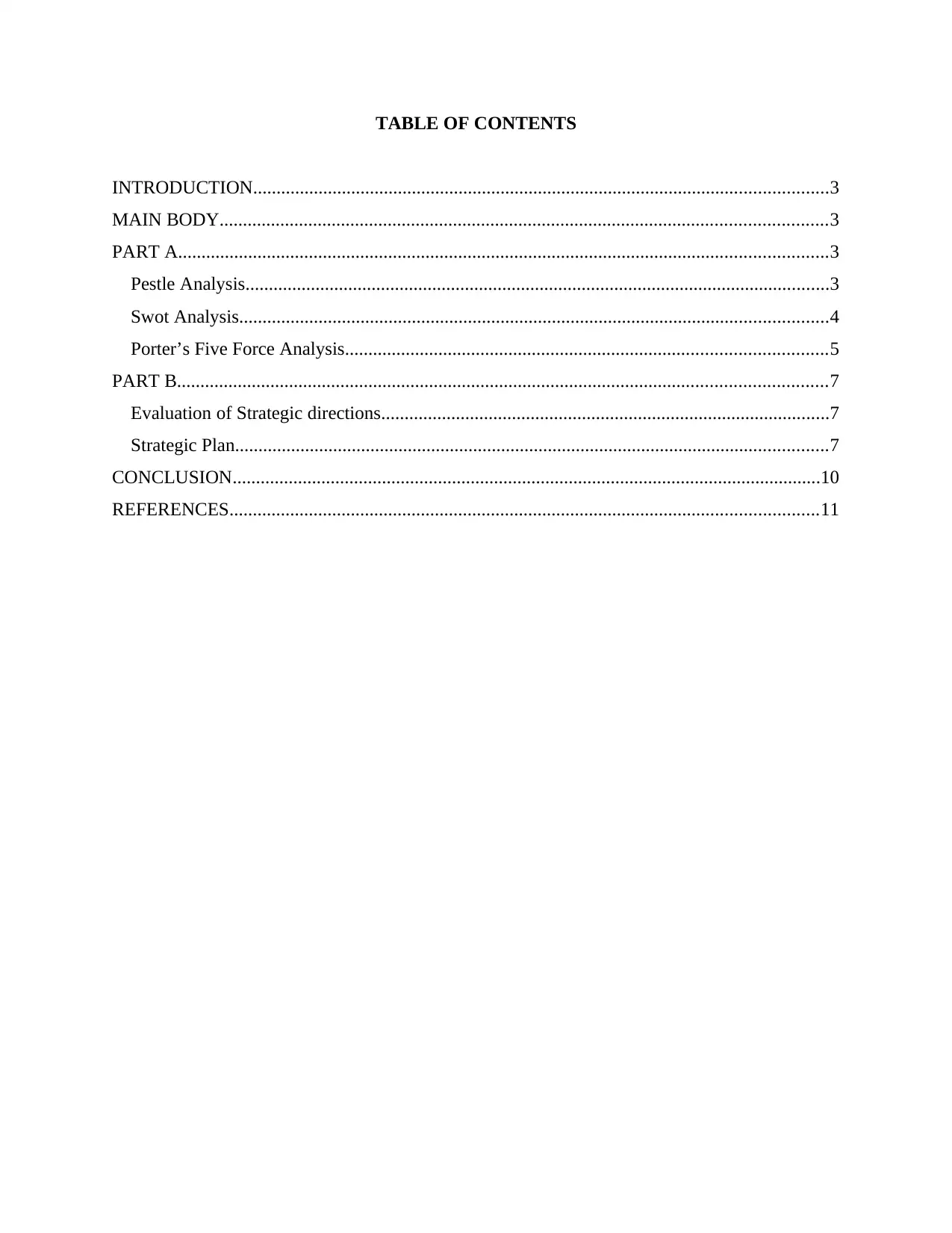
TABLE OF CONTENTS
INTRODUCTION...........................................................................................................................3
MAIN BODY..................................................................................................................................3
PART A...........................................................................................................................................3
Pestle Analysis.............................................................................................................................3
Swot Analysis..............................................................................................................................4
Porter’s Five Force Analysis.......................................................................................................5
PART B...........................................................................................................................................7
Evaluation of Strategic directions................................................................................................7
Strategic Plan...............................................................................................................................7
CONCLUSION..............................................................................................................................10
REFERENCES..............................................................................................................................11
INTRODUCTION...........................................................................................................................3
MAIN BODY..................................................................................................................................3
PART A...........................................................................................................................................3
Pestle Analysis.............................................................................................................................3
Swot Analysis..............................................................................................................................4
Porter’s Five Force Analysis.......................................................................................................5
PART B...........................................................................................................................................7
Evaluation of Strategic directions................................................................................................7
Strategic Plan...............................................................................................................................7
CONCLUSION..............................................................................................................................10
REFERENCES..............................................................................................................................11
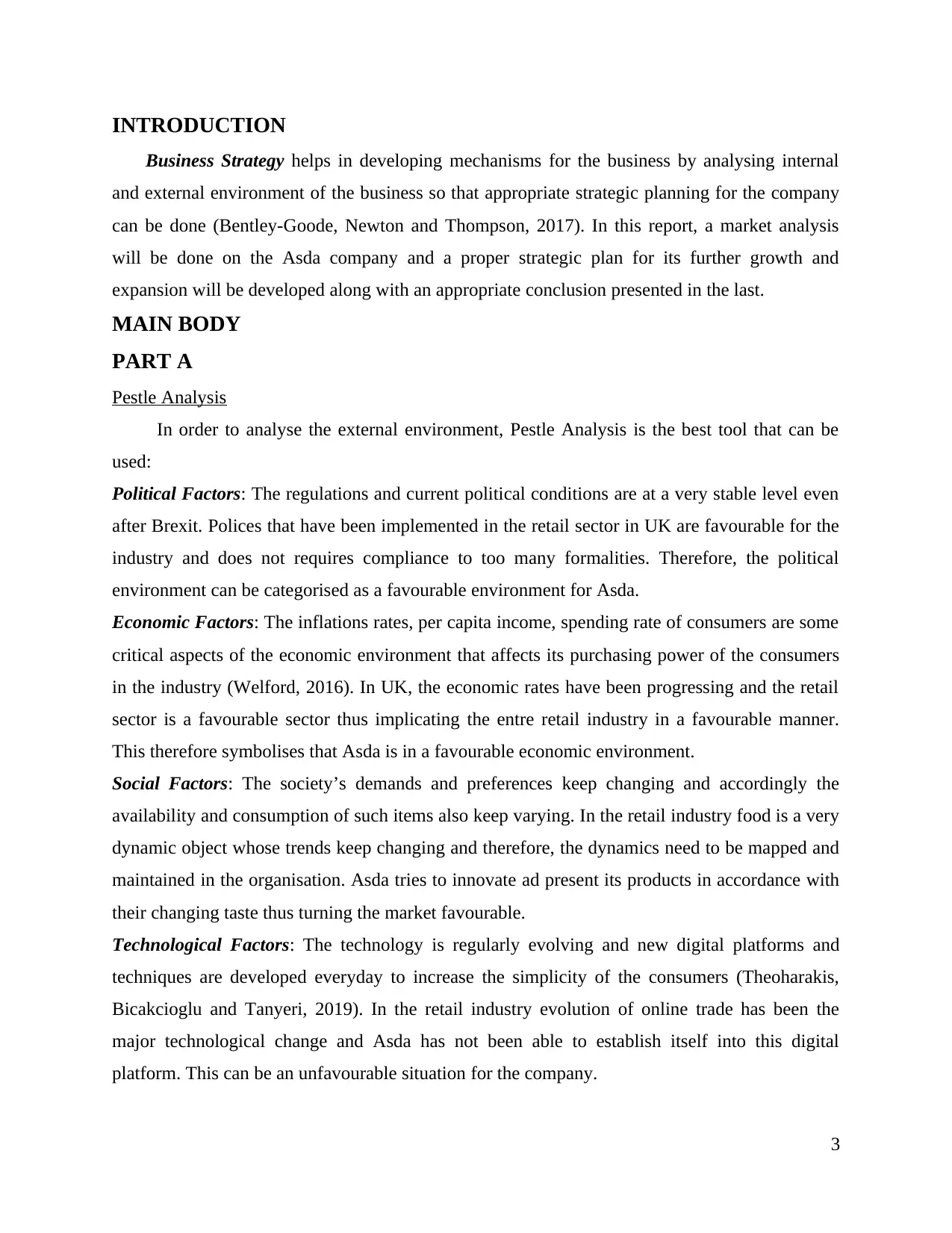
INTRODUCTION
Business Strategy helps in developing mechanisms for the business by analysing internal
and external environment of the business so that appropriate strategic planning for the company
can be done (Bentley-Goode, Newton and Thompson, 2017). In this report, a market analysis
will be done on the Asda company and a proper strategic plan for its further growth and
expansion will be developed along with an appropriate conclusion presented in the last.
MAIN BODY
PART A
Pestle Analysis
In order to analyse the external environment, Pestle Analysis is the best tool that can be
used:
Political Factors: The regulations and current political conditions are at a very stable level even
after Brexit. Polices that have been implemented in the retail sector in UK are favourable for the
industry and does not requires compliance to too many formalities. Therefore, the political
environment can be categorised as a favourable environment for Asda.
Economic Factors: The inflations rates, per capita income, spending rate of consumers are some
critical aspects of the economic environment that affects its purchasing power of the consumers
in the industry (Welford, 2016). In UK, the economic rates have been progressing and the retail
sector is a favourable sector thus implicating the entre retail industry in a favourable manner.
This therefore symbolises that Asda is in a favourable economic environment.
Social Factors: The society’s demands and preferences keep changing and accordingly the
availability and consumption of such items also keep varying. In the retail industry food is a very
dynamic object whose trends keep changing and therefore, the dynamics need to be mapped and
maintained in the organisation. Asda tries to innovate ad present its products in accordance with
their changing taste thus turning the market favourable.
Technological Factors: The technology is regularly evolving and new digital platforms and
techniques are developed everyday to increase the simplicity of the consumers (Theoharakis,
Bicakcioglu and Tanyeri, 2019). In the retail industry evolution of online trade has been the
major technological change and Asda has not been able to establish itself into this digital
platform. This can be an unfavourable situation for the company.
3
Business Strategy helps in developing mechanisms for the business by analysing internal
and external environment of the business so that appropriate strategic planning for the company
can be done (Bentley-Goode, Newton and Thompson, 2017). In this report, a market analysis
will be done on the Asda company and a proper strategic plan for its further growth and
expansion will be developed along with an appropriate conclusion presented in the last.
MAIN BODY
PART A
Pestle Analysis
In order to analyse the external environment, Pestle Analysis is the best tool that can be
used:
Political Factors: The regulations and current political conditions are at a very stable level even
after Brexit. Polices that have been implemented in the retail sector in UK are favourable for the
industry and does not requires compliance to too many formalities. Therefore, the political
environment can be categorised as a favourable environment for Asda.
Economic Factors: The inflations rates, per capita income, spending rate of consumers are some
critical aspects of the economic environment that affects its purchasing power of the consumers
in the industry (Welford, 2016). In UK, the economic rates have been progressing and the retail
sector is a favourable sector thus implicating the entre retail industry in a favourable manner.
This therefore symbolises that Asda is in a favourable economic environment.
Social Factors: The society’s demands and preferences keep changing and accordingly the
availability and consumption of such items also keep varying. In the retail industry food is a very
dynamic object whose trends keep changing and therefore, the dynamics need to be mapped and
maintained in the organisation. Asda tries to innovate ad present its products in accordance with
their changing taste thus turning the market favourable.
Technological Factors: The technology is regularly evolving and new digital platforms and
techniques are developed everyday to increase the simplicity of the consumers (Theoharakis,
Bicakcioglu and Tanyeri, 2019). In the retail industry evolution of online trade has been the
major technological change and Asda has not been able to establish itself into this digital
platform. This can be an unfavourable situation for the company.
3
⊘ This is a preview!⊘
Do you want full access?
Subscribe today to unlock all pages.

Trusted by 1+ million students worldwide
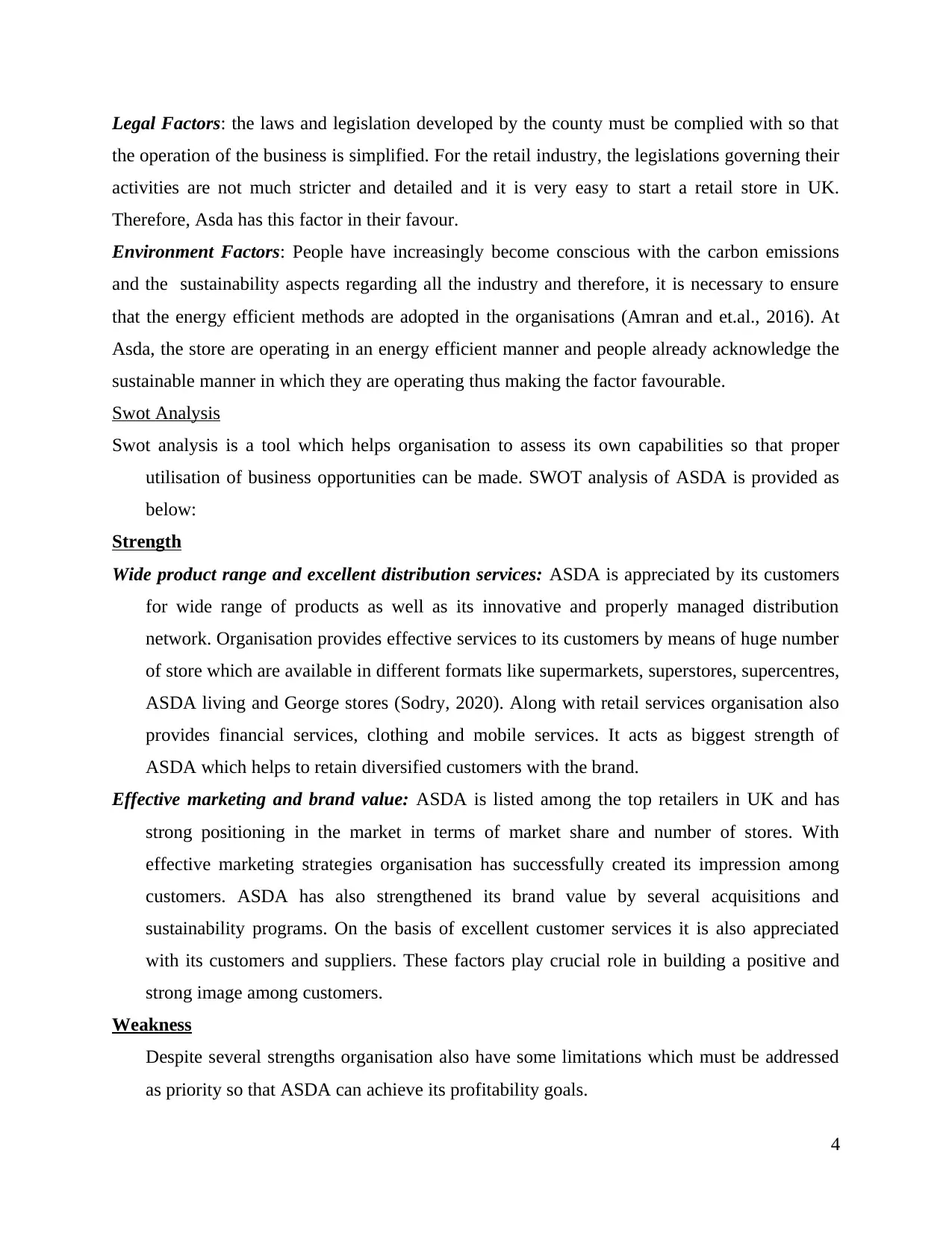
Legal Factors: the laws and legislation developed by the county must be complied with so that
the operation of the business is simplified. For the retail industry, the legislations governing their
activities are not much stricter and detailed and it is very easy to start a retail store in UK.
Therefore, Asda has this factor in their favour.
Environment Factors: People have increasingly become conscious with the carbon emissions
and the sustainability aspects regarding all the industry and therefore, it is necessary to ensure
that the energy efficient methods are adopted in the organisations (Amran and et.al., 2016). At
Asda, the store are operating in an energy efficient manner and people already acknowledge the
sustainable manner in which they are operating thus making the factor favourable.
Swot Analysis
Swot analysis is a tool which helps organisation to assess its own capabilities so that proper
utilisation of business opportunities can be made. SWOT analysis of ASDA is provided as
below:
Strength
Wide product range and excellent distribution services: ASDA is appreciated by its customers
for wide range of products as well as its innovative and properly managed distribution
network. Organisation provides effective services to its customers by means of huge number
of store which are available in different formats like supermarkets, superstores, supercentres,
ASDA living and George stores (Sodry, 2020). Along with retail services organisation also
provides financial services, clothing and mobile services. It acts as biggest strength of
ASDA which helps to retain diversified customers with the brand.
Effective marketing and brand value: ASDA is listed among the top retailers in UK and has
strong positioning in the market in terms of market share and number of stores. With
effective marketing strategies organisation has successfully created its impression among
customers. ASDA has also strengthened its brand value by several acquisitions and
sustainability programs. On the basis of excellent customer services it is also appreciated
with its customers and suppliers. These factors play crucial role in building a positive and
strong image among customers.
Weakness
Despite several strengths organisation also have some limitations which must be addressed
as priority so that ASDA can achieve its profitability goals.
4
the operation of the business is simplified. For the retail industry, the legislations governing their
activities are not much stricter and detailed and it is very easy to start a retail store in UK.
Therefore, Asda has this factor in their favour.
Environment Factors: People have increasingly become conscious with the carbon emissions
and the sustainability aspects regarding all the industry and therefore, it is necessary to ensure
that the energy efficient methods are adopted in the organisations (Amran and et.al., 2016). At
Asda, the store are operating in an energy efficient manner and people already acknowledge the
sustainable manner in which they are operating thus making the factor favourable.
Swot Analysis
Swot analysis is a tool which helps organisation to assess its own capabilities so that proper
utilisation of business opportunities can be made. SWOT analysis of ASDA is provided as
below:
Strength
Wide product range and excellent distribution services: ASDA is appreciated by its customers
for wide range of products as well as its innovative and properly managed distribution
network. Organisation provides effective services to its customers by means of huge number
of store which are available in different formats like supermarkets, superstores, supercentres,
ASDA living and George stores (Sodry, 2020). Along with retail services organisation also
provides financial services, clothing and mobile services. It acts as biggest strength of
ASDA which helps to retain diversified customers with the brand.
Effective marketing and brand value: ASDA is listed among the top retailers in UK and has
strong positioning in the market in terms of market share and number of stores. With
effective marketing strategies organisation has successfully created its impression among
customers. ASDA has also strengthened its brand value by several acquisitions and
sustainability programs. On the basis of excellent customer services it is also appreciated
with its customers and suppliers. These factors play crucial role in building a positive and
strong image among customers.
Weakness
Despite several strengths organisation also have some limitations which must be addressed
as priority so that ASDA can achieve its profitability goals.
4
Paraphrase This Document
Need a fresh take? Get an instant paraphrase of this document with our AI Paraphraser
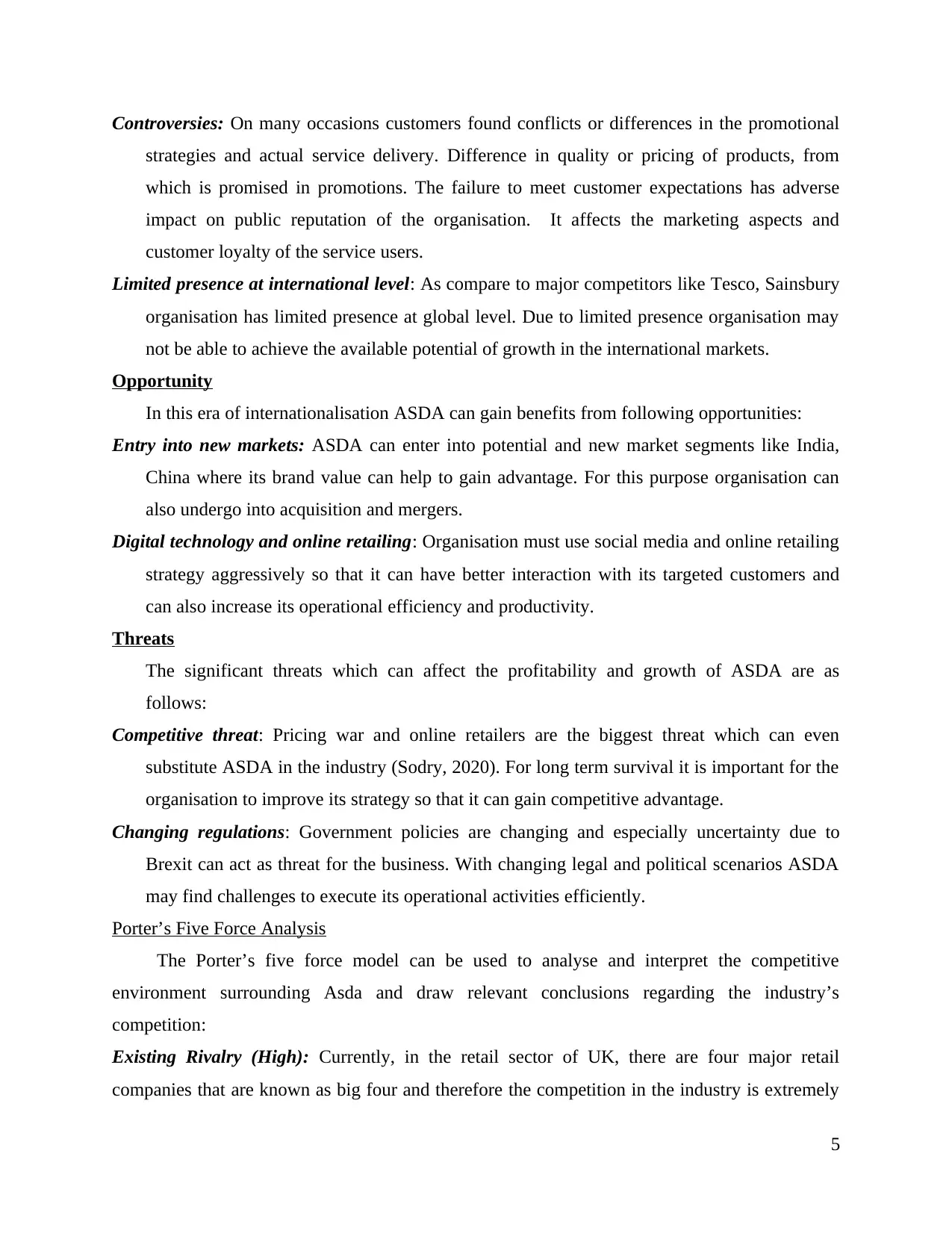
Controversies: On many occasions customers found conflicts or differences in the promotional
strategies and actual service delivery. Difference in quality or pricing of products, from
which is promised in promotions. The failure to meet customer expectations has adverse
impact on public reputation of the organisation. It affects the marketing aspects and
customer loyalty of the service users.
Limited presence at international level: As compare to major competitors like Tesco, Sainsbury
organisation has limited presence at global level. Due to limited presence organisation may
not be able to achieve the available potential of growth in the international markets.
Opportunity
In this era of internationalisation ASDA can gain benefits from following opportunities:
Entry into new markets: ASDA can enter into potential and new market segments like India,
China where its brand value can help to gain advantage. For this purpose organisation can
also undergo into acquisition and mergers.
Digital technology and online retailing: Organisation must use social media and online retailing
strategy aggressively so that it can have better interaction with its targeted customers and
can also increase its operational efficiency and productivity.
Threats
The significant threats which can affect the profitability and growth of ASDA are as
follows:
Competitive threat: Pricing war and online retailers are the biggest threat which can even
substitute ASDA in the industry (Sodry, 2020). For long term survival it is important for the
organisation to improve its strategy so that it can gain competitive advantage.
Changing regulations: Government policies are changing and especially uncertainty due to
Brexit can act as threat for the business. With changing legal and political scenarios ASDA
may find challenges to execute its operational activities efficiently.
Porter’s Five Force Analysis
The Porter’s five force model can be used to analyse and interpret the competitive
environment surrounding Asda and draw relevant conclusions regarding the industry’s
competition:
Existing Rivalry (High): Currently, in the retail sector of UK, there are four major retail
companies that are known as big four and therefore the competition in the industry is extremely
5
strategies and actual service delivery. Difference in quality or pricing of products, from
which is promised in promotions. The failure to meet customer expectations has adverse
impact on public reputation of the organisation. It affects the marketing aspects and
customer loyalty of the service users.
Limited presence at international level: As compare to major competitors like Tesco, Sainsbury
organisation has limited presence at global level. Due to limited presence organisation may
not be able to achieve the available potential of growth in the international markets.
Opportunity
In this era of internationalisation ASDA can gain benefits from following opportunities:
Entry into new markets: ASDA can enter into potential and new market segments like India,
China where its brand value can help to gain advantage. For this purpose organisation can
also undergo into acquisition and mergers.
Digital technology and online retailing: Organisation must use social media and online retailing
strategy aggressively so that it can have better interaction with its targeted customers and
can also increase its operational efficiency and productivity.
Threats
The significant threats which can affect the profitability and growth of ASDA are as
follows:
Competitive threat: Pricing war and online retailers are the biggest threat which can even
substitute ASDA in the industry (Sodry, 2020). For long term survival it is important for the
organisation to improve its strategy so that it can gain competitive advantage.
Changing regulations: Government policies are changing and especially uncertainty due to
Brexit can act as threat for the business. With changing legal and political scenarios ASDA
may find challenges to execute its operational activities efficiently.
Porter’s Five Force Analysis
The Porter’s five force model can be used to analyse and interpret the competitive
environment surrounding Asda and draw relevant conclusions regarding the industry’s
competition:
Existing Rivalry (High): Currently, in the retail sector of UK, there are four major retail
companies that are known as big four and therefore the competition in the industry is extremely
5
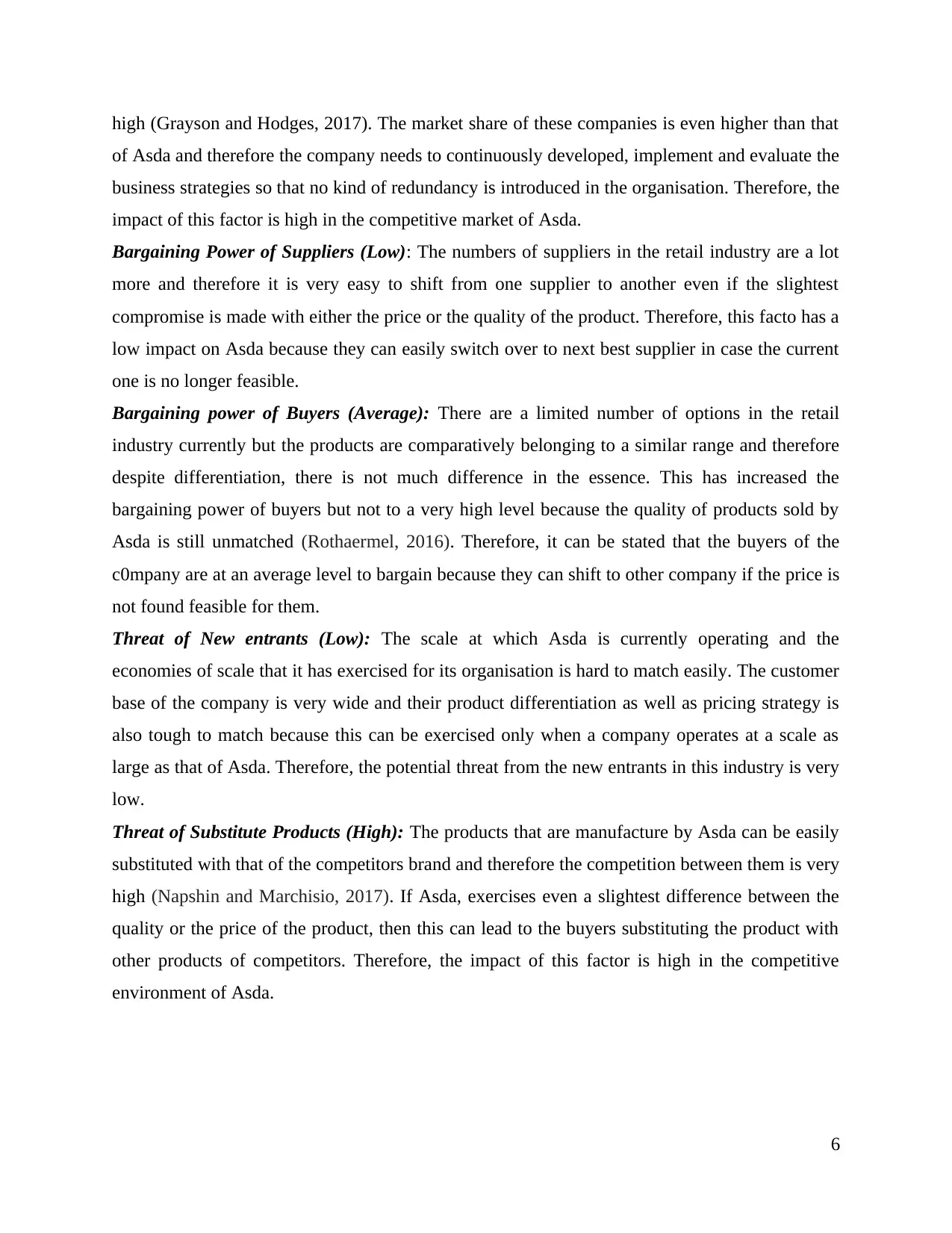
high (Grayson and Hodges, 2017). The market share of these companies is even higher than that
of Asda and therefore the company needs to continuously developed, implement and evaluate the
business strategies so that no kind of redundancy is introduced in the organisation. Therefore, the
impact of this factor is high in the competitive market of Asda.
Bargaining Power of Suppliers (Low): The numbers of suppliers in the retail industry are a lot
more and therefore it is very easy to shift from one supplier to another even if the slightest
compromise is made with either the price or the quality of the product. Therefore, this facto has a
low impact on Asda because they can easily switch over to next best supplier in case the current
one is no longer feasible.
Bargaining power of Buyers (Average): There are a limited number of options in the retail
industry currently but the products are comparatively belonging to a similar range and therefore
despite differentiation, there is not much difference in the essence. This has increased the
bargaining power of buyers but not to a very high level because the quality of products sold by
Asda is still unmatched (Rothaermel, 2016). Therefore, it can be stated that the buyers of the
c0mpany are at an average level to bargain because they can shift to other company if the price is
not found feasible for them.
Threat of New entrants (Low): The scale at which Asda is currently operating and the
economies of scale that it has exercised for its organisation is hard to match easily. The customer
base of the company is very wide and their product differentiation as well as pricing strategy is
also tough to match because this can be exercised only when a company operates at a scale as
large as that of Asda. Therefore, the potential threat from the new entrants in this industry is very
low.
Threat of Substitute Products (High): The products that are manufacture by Asda can be easily
substituted with that of the competitors brand and therefore the competition between them is very
high (Napshin and Marchisio, 2017). If Asda, exercises even a slightest difference between the
quality or the price of the product, then this can lead to the buyers substituting the product with
other products of competitors. Therefore, the impact of this factor is high in the competitive
environment of Asda.
6
of Asda and therefore the company needs to continuously developed, implement and evaluate the
business strategies so that no kind of redundancy is introduced in the organisation. Therefore, the
impact of this factor is high in the competitive market of Asda.
Bargaining Power of Suppliers (Low): The numbers of suppliers in the retail industry are a lot
more and therefore it is very easy to shift from one supplier to another even if the slightest
compromise is made with either the price or the quality of the product. Therefore, this facto has a
low impact on Asda because they can easily switch over to next best supplier in case the current
one is no longer feasible.
Bargaining power of Buyers (Average): There are a limited number of options in the retail
industry currently but the products are comparatively belonging to a similar range and therefore
despite differentiation, there is not much difference in the essence. This has increased the
bargaining power of buyers but not to a very high level because the quality of products sold by
Asda is still unmatched (Rothaermel, 2016). Therefore, it can be stated that the buyers of the
c0mpany are at an average level to bargain because they can shift to other company if the price is
not found feasible for them.
Threat of New entrants (Low): The scale at which Asda is currently operating and the
economies of scale that it has exercised for its organisation is hard to match easily. The customer
base of the company is very wide and their product differentiation as well as pricing strategy is
also tough to match because this can be exercised only when a company operates at a scale as
large as that of Asda. Therefore, the potential threat from the new entrants in this industry is very
low.
Threat of Substitute Products (High): The products that are manufacture by Asda can be easily
substituted with that of the competitors brand and therefore the competition between them is very
high (Napshin and Marchisio, 2017). If Asda, exercises even a slightest difference between the
quality or the price of the product, then this can lead to the buyers substituting the product with
other products of competitors. Therefore, the impact of this factor is high in the competitive
environment of Asda.
6
⊘ This is a preview!⊘
Do you want full access?
Subscribe today to unlock all pages.

Trusted by 1+ million students worldwide
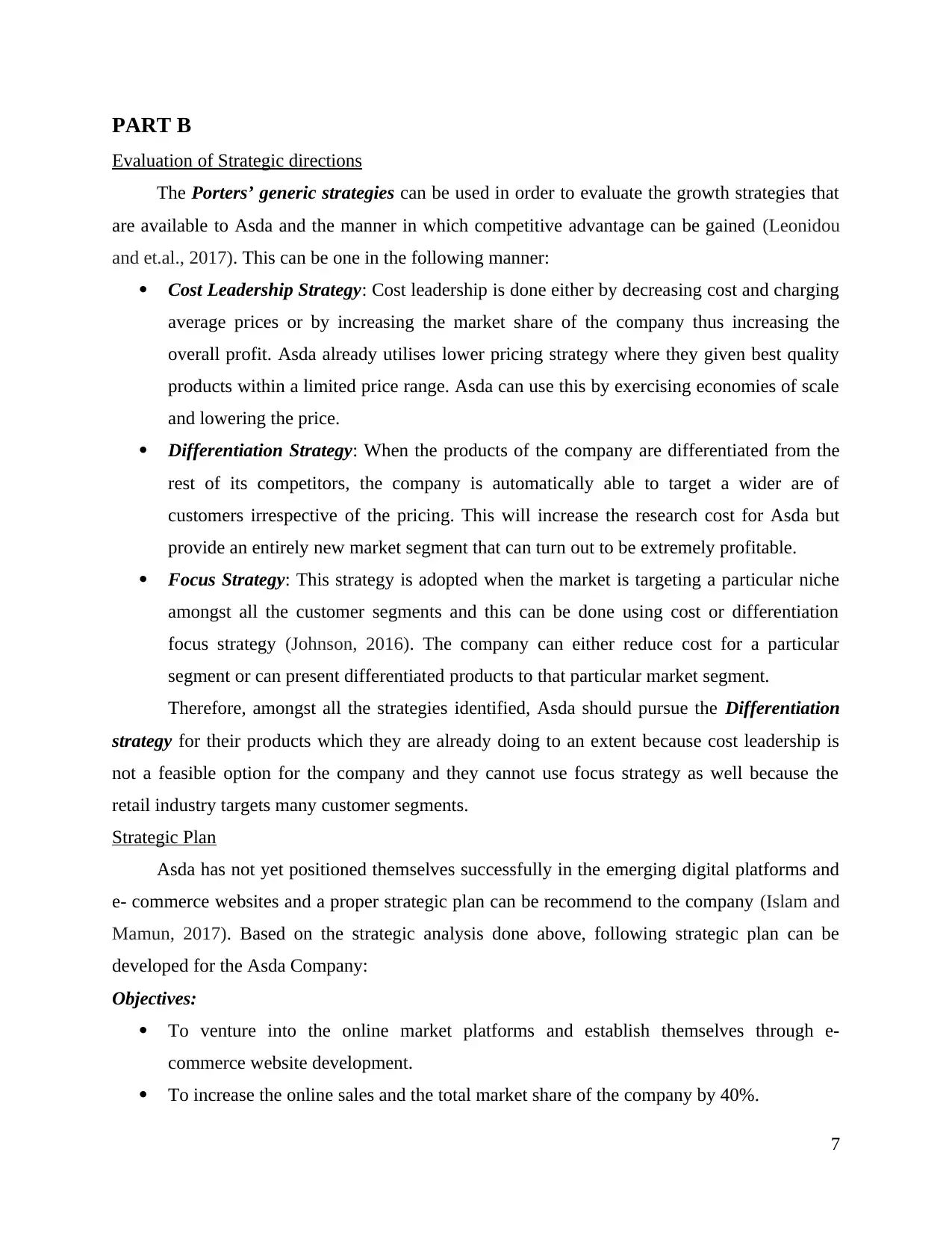
PART B
Evaluation of Strategic directions
The Porters’ generic strategies can be used in order to evaluate the growth strategies that
are available to Asda and the manner in which competitive advantage can be gained (Leonidou
and et.al., 2017). This can be one in the following manner:
Cost Leadership Strategy: Cost leadership is done either by decreasing cost and charging
average prices or by increasing the market share of the company thus increasing the
overall profit. Asda already utilises lower pricing strategy where they given best quality
products within a limited price range. Asda can use this by exercising economies of scale
and lowering the price.
Differentiation Strategy: When the products of the company are differentiated from the
rest of its competitors, the company is automatically able to target a wider are of
customers irrespective of the pricing. This will increase the research cost for Asda but
provide an entirely new market segment that can turn out to be extremely profitable.
Focus Strategy: This strategy is adopted when the market is targeting a particular niche
amongst all the customer segments and this can be done using cost or differentiation
focus strategy (Johnson, 2016). The company can either reduce cost for a particular
segment or can present differentiated products to that particular market segment.
Therefore, amongst all the strategies identified, Asda should pursue the Differentiation
strategy for their products which they are already doing to an extent because cost leadership is
not a feasible option for the company and they cannot use focus strategy as well because the
retail industry targets many customer segments.
Strategic Plan
Asda has not yet positioned themselves successfully in the emerging digital platforms and
e- commerce websites and a proper strategic plan can be recommend to the company (Islam and
Mamun, 2017). Based on the strategic analysis done above, following strategic plan can be
developed for the Asda Company:
Objectives:
To venture into the online market platforms and establish themselves through e-
commerce website development.
To increase the online sales and the total market share of the company by 40%.
7
Evaluation of Strategic directions
The Porters’ generic strategies can be used in order to evaluate the growth strategies that
are available to Asda and the manner in which competitive advantage can be gained (Leonidou
and et.al., 2017). This can be one in the following manner:
Cost Leadership Strategy: Cost leadership is done either by decreasing cost and charging
average prices or by increasing the market share of the company thus increasing the
overall profit. Asda already utilises lower pricing strategy where they given best quality
products within a limited price range. Asda can use this by exercising economies of scale
and lowering the price.
Differentiation Strategy: When the products of the company are differentiated from the
rest of its competitors, the company is automatically able to target a wider are of
customers irrespective of the pricing. This will increase the research cost for Asda but
provide an entirely new market segment that can turn out to be extremely profitable.
Focus Strategy: This strategy is adopted when the market is targeting a particular niche
amongst all the customer segments and this can be done using cost or differentiation
focus strategy (Johnson, 2016). The company can either reduce cost for a particular
segment or can present differentiated products to that particular market segment.
Therefore, amongst all the strategies identified, Asda should pursue the Differentiation
strategy for their products which they are already doing to an extent because cost leadership is
not a feasible option for the company and they cannot use focus strategy as well because the
retail industry targets many customer segments.
Strategic Plan
Asda has not yet positioned themselves successfully in the emerging digital platforms and
e- commerce websites and a proper strategic plan can be recommend to the company (Islam and
Mamun, 2017). Based on the strategic analysis done above, following strategic plan can be
developed for the Asda Company:
Objectives:
To venture into the online market platforms and establish themselves through e-
commerce website development.
To increase the online sales and the total market share of the company by 40%.
7
Paraphrase This Document
Need a fresh take? Get an instant paraphrase of this document with our AI Paraphraser
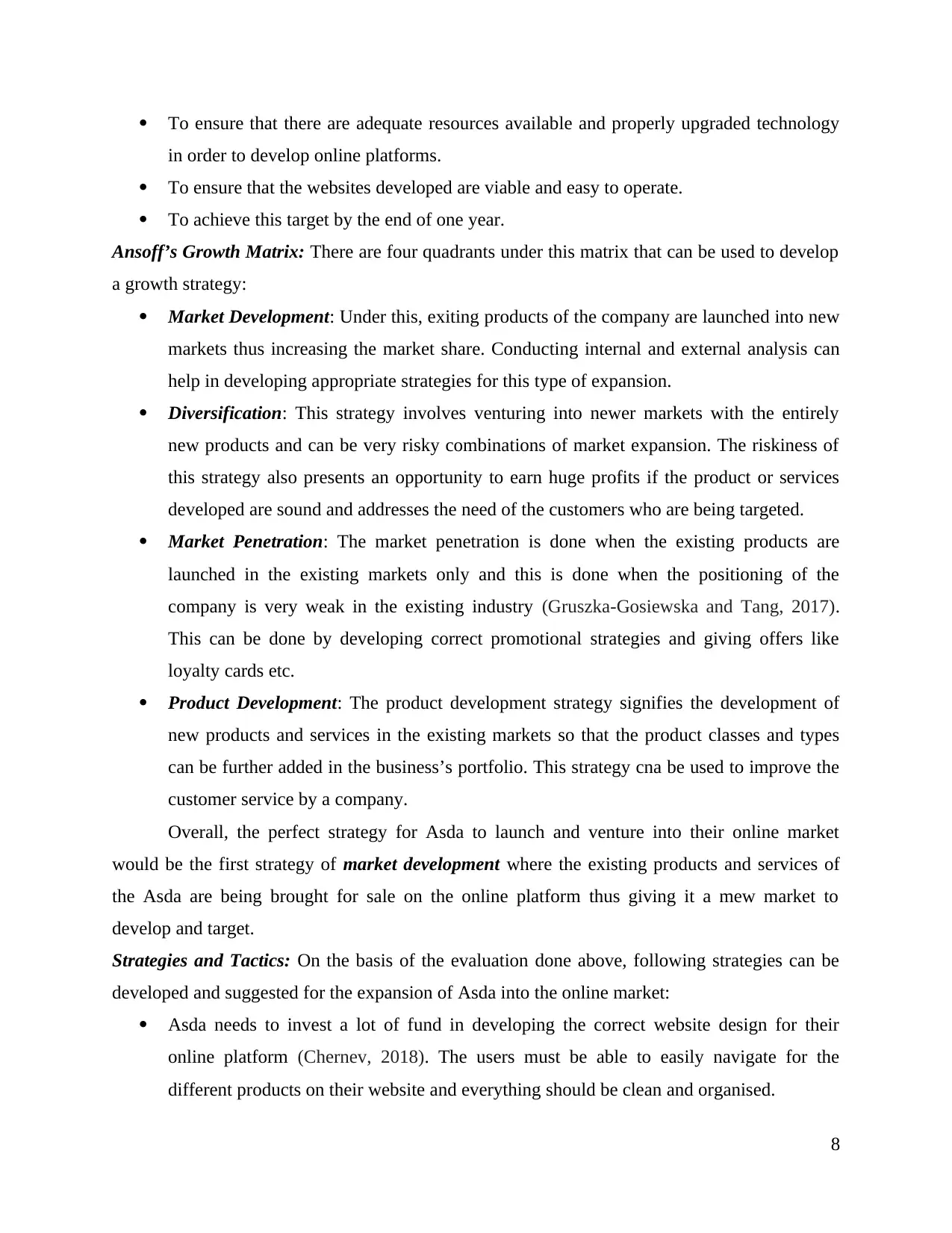
To ensure that there are adequate resources available and properly upgraded technology
in order to develop online platforms.
To ensure that the websites developed are viable and easy to operate.
To achieve this target by the end of one year.
Ansoff’s Growth Matrix: There are four quadrants under this matrix that can be used to develop
a growth strategy:
Market Development: Under this, exiting products of the company are launched into new
markets thus increasing the market share. Conducting internal and external analysis can
help in developing appropriate strategies for this type of expansion.
Diversification: This strategy involves venturing into newer markets with the entirely
new products and can be very risky combinations of market expansion. The riskiness of
this strategy also presents an opportunity to earn huge profits if the product or services
developed are sound and addresses the need of the customers who are being targeted.
Market Penetration: The market penetration is done when the existing products are
launched in the existing markets only and this is done when the positioning of the
company is very weak in the existing industry (Gruszka-Gosiewska and Tang, 2017).
This can be done by developing correct promotional strategies and giving offers like
loyalty cards etc.
Product Development: The product development strategy signifies the development of
new products and services in the existing markets so that the product classes and types
can be further added in the business’s portfolio. This strategy cna be used to improve the
customer service by a company.
Overall, the perfect strategy for Asda to launch and venture into their online market
would be the first strategy of market development where the existing products and services of
the Asda are being brought for sale on the online platform thus giving it a mew market to
develop and target.
Strategies and Tactics: On the basis of the evaluation done above, following strategies can be
developed and suggested for the expansion of Asda into the online market:
Asda needs to invest a lot of fund in developing the correct website design for their
online platform (Chernev, 2018). The users must be able to easily navigate for the
different products on their website and everything should be clean and organised.
8
in order to develop online platforms.
To ensure that the websites developed are viable and easy to operate.
To achieve this target by the end of one year.
Ansoff’s Growth Matrix: There are four quadrants under this matrix that can be used to develop
a growth strategy:
Market Development: Under this, exiting products of the company are launched into new
markets thus increasing the market share. Conducting internal and external analysis can
help in developing appropriate strategies for this type of expansion.
Diversification: This strategy involves venturing into newer markets with the entirely
new products and can be very risky combinations of market expansion. The riskiness of
this strategy also presents an opportunity to earn huge profits if the product or services
developed are sound and addresses the need of the customers who are being targeted.
Market Penetration: The market penetration is done when the existing products are
launched in the existing markets only and this is done when the positioning of the
company is very weak in the existing industry (Gruszka-Gosiewska and Tang, 2017).
This can be done by developing correct promotional strategies and giving offers like
loyalty cards etc.
Product Development: The product development strategy signifies the development of
new products and services in the existing markets so that the product classes and types
can be further added in the business’s portfolio. This strategy cna be used to improve the
customer service by a company.
Overall, the perfect strategy for Asda to launch and venture into their online market
would be the first strategy of market development where the existing products and services of
the Asda are being brought for sale on the online platform thus giving it a mew market to
develop and target.
Strategies and Tactics: On the basis of the evaluation done above, following strategies can be
developed and suggested for the expansion of Asda into the online market:
Asda needs to invest a lot of fund in developing the correct website design for their
online platform (Chernev, 2018). The users must be able to easily navigate for the
different products on their website and everything should be clean and organised.
8
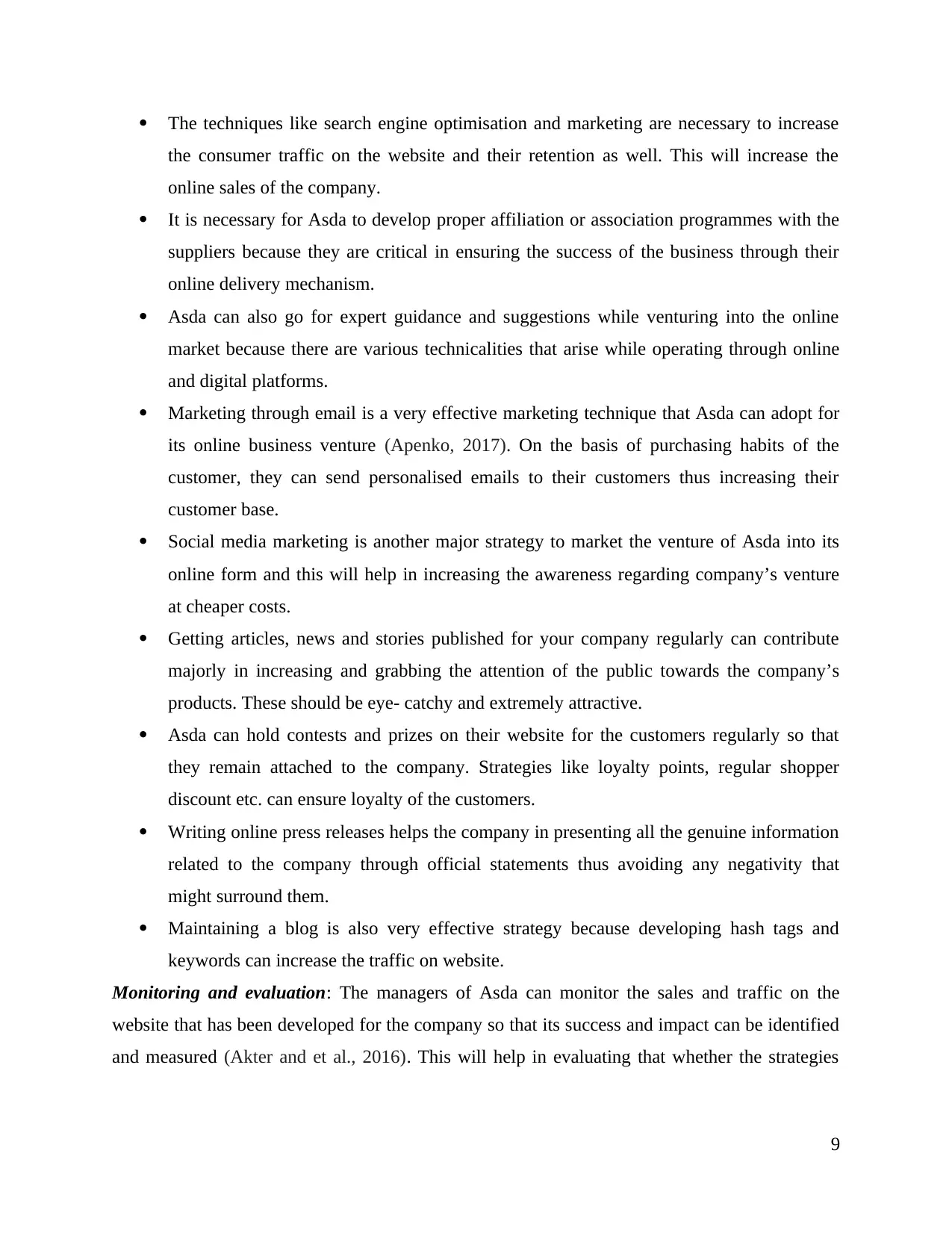
The techniques like search engine optimisation and marketing are necessary to increase
the consumer traffic on the website and their retention as well. This will increase the
online sales of the company.
It is necessary for Asda to develop proper affiliation or association programmes with the
suppliers because they are critical in ensuring the success of the business through their
online delivery mechanism.
Asda can also go for expert guidance and suggestions while venturing into the online
market because there are various technicalities that arise while operating through online
and digital platforms.
Marketing through email is a very effective marketing technique that Asda can adopt for
its online business venture (Apenko, 2017). On the basis of purchasing habits of the
customer, they can send personalised emails to their customers thus increasing their
customer base.
Social media marketing is another major strategy to market the venture of Asda into its
online form and this will help in increasing the awareness regarding company’s venture
at cheaper costs.
Getting articles, news and stories published for your company regularly can contribute
majorly in increasing and grabbing the attention of the public towards the company’s
products. These should be eye- catchy and extremely attractive.
Asda can hold contests and prizes on their website for the customers regularly so that
they remain attached to the company. Strategies like loyalty points, regular shopper
discount etc. can ensure loyalty of the customers.
Writing online press releases helps the company in presenting all the genuine information
related to the company through official statements thus avoiding any negativity that
might surround them.
Maintaining a blog is also very effective strategy because developing hash tags and
keywords can increase the traffic on website.
Monitoring and evaluation: The managers of Asda can monitor the sales and traffic on the
website that has been developed for the company so that its success and impact can be identified
and measured (Akter and et al., 2016). This will help in evaluating that whether the strategies
9
the consumer traffic on the website and their retention as well. This will increase the
online sales of the company.
It is necessary for Asda to develop proper affiliation or association programmes with the
suppliers because they are critical in ensuring the success of the business through their
online delivery mechanism.
Asda can also go for expert guidance and suggestions while venturing into the online
market because there are various technicalities that arise while operating through online
and digital platforms.
Marketing through email is a very effective marketing technique that Asda can adopt for
its online business venture (Apenko, 2017). On the basis of purchasing habits of the
customer, they can send personalised emails to their customers thus increasing their
customer base.
Social media marketing is another major strategy to market the venture of Asda into its
online form and this will help in increasing the awareness regarding company’s venture
at cheaper costs.
Getting articles, news and stories published for your company regularly can contribute
majorly in increasing and grabbing the attention of the public towards the company’s
products. These should be eye- catchy and extremely attractive.
Asda can hold contests and prizes on their website for the customers regularly so that
they remain attached to the company. Strategies like loyalty points, regular shopper
discount etc. can ensure loyalty of the customers.
Writing online press releases helps the company in presenting all the genuine information
related to the company through official statements thus avoiding any negativity that
might surround them.
Maintaining a blog is also very effective strategy because developing hash tags and
keywords can increase the traffic on website.
Monitoring and evaluation: The managers of Asda can monitor the sales and traffic on the
website that has been developed for the company so that its success and impact can be identified
and measured (Akter and et al., 2016). This will help in evaluating that whether the strategies
9
⊘ This is a preview!⊘
Do you want full access?
Subscribe today to unlock all pages.

Trusted by 1+ million students worldwide
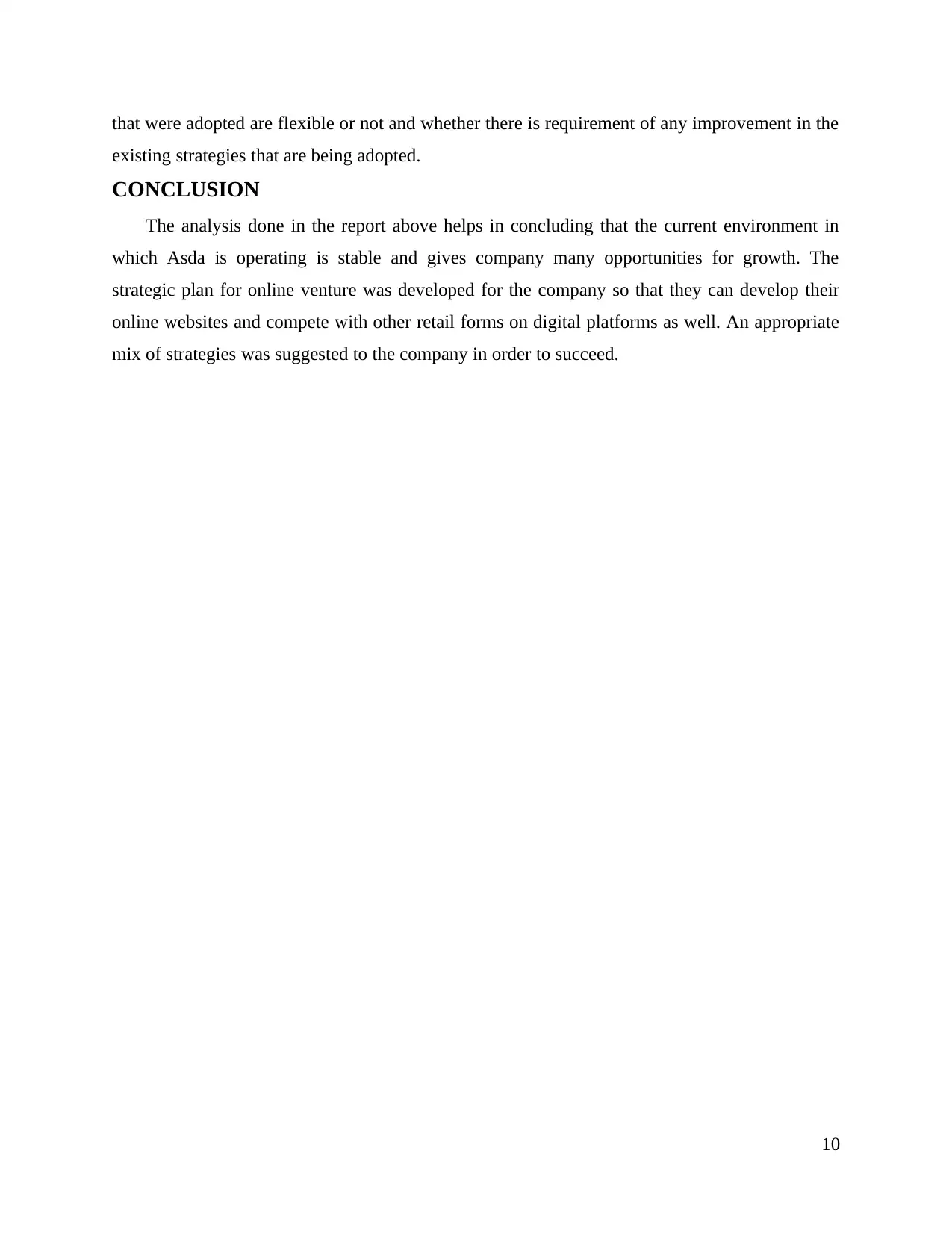
that were adopted are flexible or not and whether there is requirement of any improvement in the
existing strategies that are being adopted.
CONCLUSION
The analysis done in the report above helps in concluding that the current environment in
which Asda is operating is stable and gives company many opportunities for growth. The
strategic plan for online venture was developed for the company so that they can develop their
online websites and compete with other retail forms on digital platforms as well. An appropriate
mix of strategies was suggested to the company in order to succeed.
10
existing strategies that are being adopted.
CONCLUSION
The analysis done in the report above helps in concluding that the current environment in
which Asda is operating is stable and gives company many opportunities for growth. The
strategic plan for online venture was developed for the company so that they can develop their
online websites and compete with other retail forms on digital platforms as well. An appropriate
mix of strategies was suggested to the company in order to succeed.
10
Paraphrase This Document
Need a fresh take? Get an instant paraphrase of this document with our AI Paraphraser
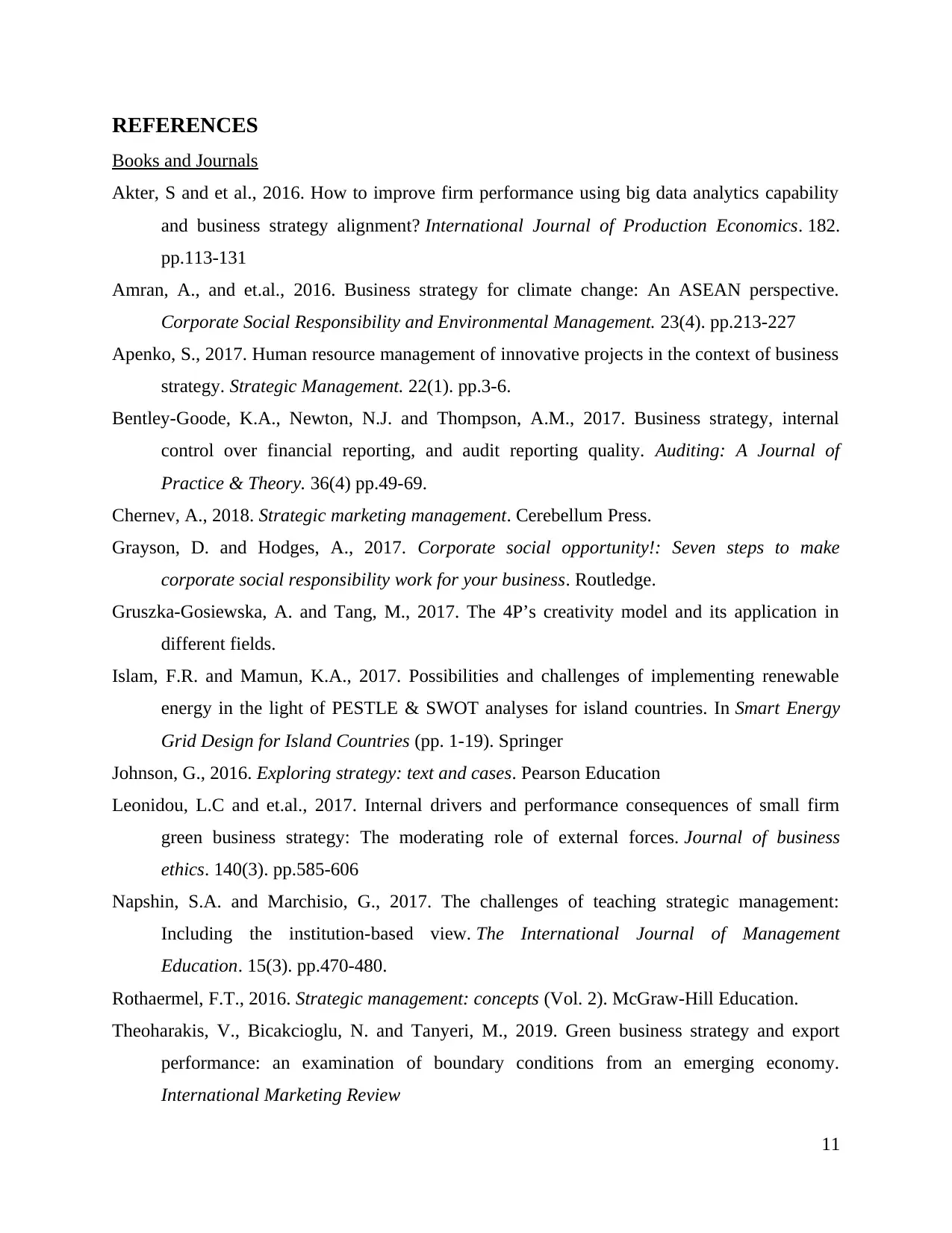
REFERENCES
Books and Journals
Akter, S and et al., 2016. How to improve firm performance using big data analytics capability
and business strategy alignment? International Journal of Production Economics. 182.
pp.113-131
Amran, A., and et.al., 2016. Business strategy for climate change: An ASEAN perspective.
Corporate Social Responsibility and Environmental Management. 23(4). pp.213-227
Apenko, S., 2017. Human resource management of innovative projects in the context of business
strategy. Strategic Management. 22(1). pp.3-6.
Bentley-Goode, K.A., Newton, N.J. and Thompson, A.M., 2017. Business strategy, internal
control over financial reporting, and audit reporting quality. Auditing: A Journal of
Practice & Theory. 36(4) pp.49-69.
Chernev, A., 2018. Strategic marketing management. Cerebellum Press.
Grayson, D. and Hodges, A., 2017. Corporate social opportunity!: Seven steps to make
corporate social responsibility work for your business. Routledge.
Gruszka-Gosiewska, A. and Tang, M., 2017. The 4P’s creativity model and its application in
different fields.
Islam, F.R. and Mamun, K.A., 2017. Possibilities and challenges of implementing renewable
energy in the light of PESTLE & SWOT analyses for island countries. In Smart Energy
Grid Design for Island Countries (pp. 1-19). Springer
Johnson, G., 2016. Exploring strategy: text and cases. Pearson Education
Leonidou, L.C and et.al., 2017. Internal drivers and performance consequences of small firm
green business strategy: The moderating role of external forces. Journal of business
ethics. 140(3). pp.585-606
Napshin, S.A. and Marchisio, G., 2017. The challenges of teaching strategic management:
Including the institution-based view. The International Journal of Management
Education. 15(3). pp.470-480.
Rothaermel, F.T., 2016. Strategic management: concepts (Vol. 2). McGraw-Hill Education.
Theoharakis, V., Bicakcioglu, N. and Tanyeri, M., 2019. Green business strategy and export
performance: an examination of boundary conditions from an emerging economy.
International Marketing Review
11
Books and Journals
Akter, S and et al., 2016. How to improve firm performance using big data analytics capability
and business strategy alignment? International Journal of Production Economics. 182.
pp.113-131
Amran, A., and et.al., 2016. Business strategy for climate change: An ASEAN perspective.
Corporate Social Responsibility and Environmental Management. 23(4). pp.213-227
Apenko, S., 2017. Human resource management of innovative projects in the context of business
strategy. Strategic Management. 22(1). pp.3-6.
Bentley-Goode, K.A., Newton, N.J. and Thompson, A.M., 2017. Business strategy, internal
control over financial reporting, and audit reporting quality. Auditing: A Journal of
Practice & Theory. 36(4) pp.49-69.
Chernev, A., 2018. Strategic marketing management. Cerebellum Press.
Grayson, D. and Hodges, A., 2017. Corporate social opportunity!: Seven steps to make
corporate social responsibility work for your business. Routledge.
Gruszka-Gosiewska, A. and Tang, M., 2017. The 4P’s creativity model and its application in
different fields.
Islam, F.R. and Mamun, K.A., 2017. Possibilities and challenges of implementing renewable
energy in the light of PESTLE & SWOT analyses for island countries. In Smart Energy
Grid Design for Island Countries (pp. 1-19). Springer
Johnson, G., 2016. Exploring strategy: text and cases. Pearson Education
Leonidou, L.C and et.al., 2017. Internal drivers and performance consequences of small firm
green business strategy: The moderating role of external forces. Journal of business
ethics. 140(3). pp.585-606
Napshin, S.A. and Marchisio, G., 2017. The challenges of teaching strategic management:
Including the institution-based view. The International Journal of Management
Education. 15(3). pp.470-480.
Rothaermel, F.T., 2016. Strategic management: concepts (Vol. 2). McGraw-Hill Education.
Theoharakis, V., Bicakcioglu, N. and Tanyeri, M., 2019. Green business strategy and export
performance: an examination of boundary conditions from an emerging economy.
International Marketing Review
11

Welford, R., 2016. Corporate environmental management 1: Systems and strategies. Routledge.
Online
Sodry, S., 2020. SWOT analysis of ASDA. [Online]. Accessed through <
https://www.howandwhat.net/swot-analysis-asda/ >.
12
Online
Sodry, S., 2020. SWOT analysis of ASDA. [Online]. Accessed through <
https://www.howandwhat.net/swot-analysis-asda/ >.
12
⊘ This is a preview!⊘
Do you want full access?
Subscribe today to unlock all pages.

Trusted by 1+ million students worldwide
1 out of 14
Related Documents
Your All-in-One AI-Powered Toolkit for Academic Success.
+13062052269
info@desklib.com
Available 24*7 on WhatsApp / Email
![[object Object]](/_next/static/media/star-bottom.7253800d.svg)
Unlock your academic potential
Copyright © 2020–2025 A2Z Services. All Rights Reserved. Developed and managed by ZUCOL.





